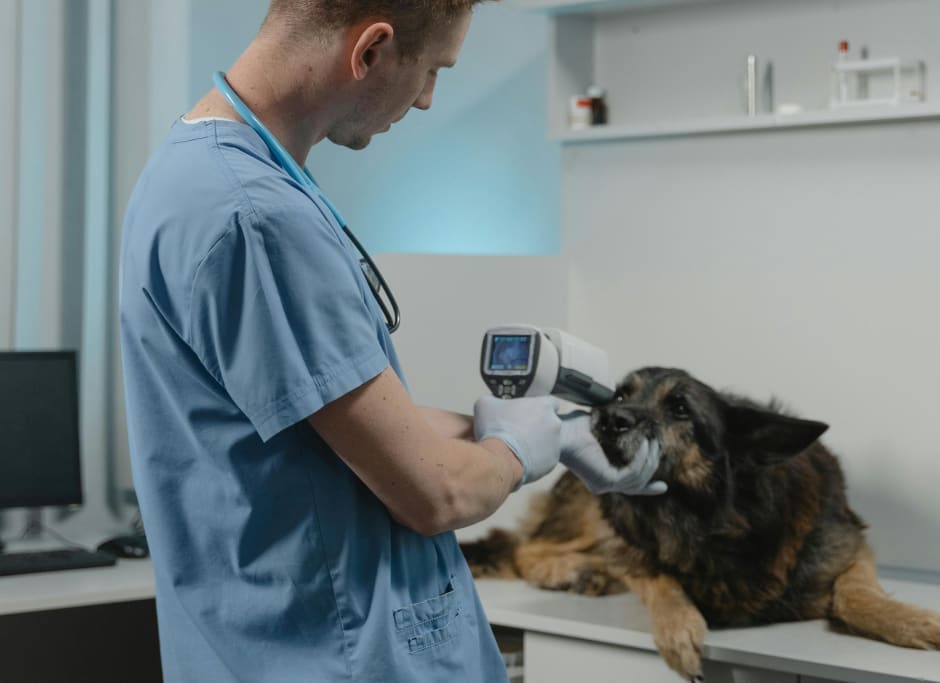As a veterinary radiologist, it’ll be your job to analyze various diagnostic images to help diagnose illnesses and injuries in animals. Veterinary radiologists are well-versed in looking at all sorts of different medical imagery, including CT scans, radiographs, MRIs, and X-rays. Veterinary radiologists will often report their findings, in case form, directly to a veterinarian. Some veterinary radiologists may also offer suggestions on treatment plans.
Becoming a veterinary radiologist is not an easy job. You’d need to have a full understanding of the anatomy of many types of animals, work computers properly, and have exemplary communication skills to ensure that your diagnosis suggestions can be understood. As many images can be tough to read, veterinary radiologists also need to be very detail-oriented and require a huge amount of patience.
It isn’t easy to get to this position, either. First, you need to obtain a college degree, then attend medical school and take a radiologist’s exam. Those who enter the profession can expect to earn around $56,000 per year, but a growing demand over the next few years could potentially increase this figure.
Let’s give you a more thorough overview of becoming a veterinary radiologist.
Steps to Become a Veterinary Radiologist
As we said, it is a long route to becoming a veterinary radiologist. It is a position only for the most determined of people. We are going to assume that you’re already trying your best at High School, so our ‘pathway’ will start with your first college degree.
Bachelor’s Degree:
You’ll need a bachelor’s degree in biological and natural sciences. The closer the bachelor’s degree is to veterinary work, the better. It increases your chances of getting into med school.
On-the-Job Experience:
Technically, this isn’t required. However, we find it essential if you’re committing yourself to this vocation. Try to get work experience with a vet (ask your local humane society) to see how everything works. This will help with future education applications while also helping you decide whether this is really the job for you.
MCAT:
You’ve graduated? Great! You now need to do the Medical College Admissions Test, or MCAT for short. The better you perform on this test, the more chance you have of being accepted to med school.
Veterinary School:
Your next step is four years at veterinary school. You’ll learn everything about veterinary work here. You won’t be specializing in radiology quite yet, although some of that will come up in the course.
Residency Program:
Once you’ve graduated from veterinary school, you’ll need to look for a residency program for veterinary radiologists. This will take about two to three years to complete, but you’ll be doing a lot of on-the-job work. This is where you’ll learn the ins and outs of radiology. It is recommended that most people follow a three-year course, as that is what all the major universities offer. It is the only way to ensure that all aspects of radiology are taught adequately, and should make it easier for people to get a job.
American College of Veterinary Radiologists Exam:
The final step to gain your certification is to complete this exam. Once you’ve completed it, you can work on your own as a radiologist. You will need to lean on everything that you learned during your residency program for this. This is why you should head to a top veterinary school. They spend a lot of time focusing on ensuring that this exam can be passed.
Further Education:
In order to continue working as a radiologist, you’ll need to take additional courses each year. These courses change depending on advancements in the field, and you’ll be given all relevant information once certified. There will normally be something that needs to be done every single year.
Top Veterinary Radiologist Program
There are a number of schools across the US that offer veterinary radiology programs. While top performance at any school can really assist you with getting the role you want, these are the best colleges:
Ohio State University
Columbus, OH Campus Only
This is regarded as one of the best schools for veterinary radiology. At Ohio State University, you can learn to work on radiography for both large and small animals. The university offers regular training to ensure that students are prepared for their final certification exam.
Tuition
Call for DetailsContact
(614) 292-1171
green.689@osu.edu
North Carolina State University
Raleigh, NC Campus Only
North Carolina State University is one of the best schools for students looking for a residency in veterinary radiology. The residency is three years long, slightly longer than normal, but it provides extensive education. Students often get a good leg-up in the industry here because they are required to publish in a peer-reviewed journal before graduation.
Tuition
Call for DetailsContact
(919) 513-6786
ebcohen@ncsu.edu
University of Georgia
Athens, GA Campus Only
The University of Georgia also offers an extensive three-year residency program. There is a lot more focus on exotic animals here, although more common large and small animals are also worked with. Students will need to help teach veterinary courses here, helping to pass their education on to the next generation.
Tuition
Call for DetailsContact
(706) 542-6484
ktracy@uga.edu
University of Pennsylvania
Philadelphia, PA Campus Only
Students at the University of Pennsylvania will work with some of the best teaching radiologists in the business. They’ll also work at large and small clinics, often equipped with state-of-the-art diagnostic equipment, to really get practical experience. The residency lasts for three years and is highly regarded when looking for future jobs in the industry.
Tuition
Call for DetailsContact
(215) 898-3304
wmai@vet.upenn.edu
University of Wisconsin
Madison, WI Campus Only
The University of Wisconsin focuses on all aspects of veterinary radiology. The course is divided into very specific areas, ensuring that students always receive proper training. The focus is also on more modern techniques.
Tuition
Call for DetailsContact
(608) 263-7600
gillian.mclellan@wisc.edu
License Requirements
To become a veterinary radiologist, a person must:
- Complete a bachelor’s degree.
- Pass the MCAT
- Attend and graduate from veterinary school.
- Complete a residency program in veterinary radiology.
- Complete the American College of Veterinary Radiologists certifying exam.
Completing the exam doesn’t mean a person maintains their radiology status for life. The license will come up for regular renewal. This may require a lot of further education to ensure that the license holder is keeping up to date with the modern trends in radiology and constant examinations. This ensures that only the best radiologists continue to work in the industry.
Salary and Career Outlook
The average veterinary radiologist can expect to earn around $56,000 per year in 2024. However, there is every indication that this figure can rise. At the moment, there is a growing demand for veterinary radiologists. It is estimated that over the next 5-10 years, the number of radiologists required will grow by 10%. This means that top performers should have no issues finding a job.
Veterinary radiologists have quite varied careers, too. Some work only with other vets, ensuring the proper diagnosis of their patients. Others may end up working in the research sector, with many published papers to their name. Some may even develop new treatments and diagnostic tools. It certainly isn’t a boring job.





